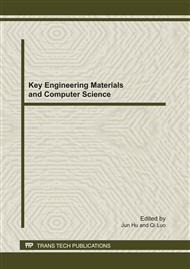[1]
F. Allower, A. Zheng. Nonliear model predictive control. Progress in System and Control Theory, 2000, 26. Birkhauser: Basel, Switzerland.
Google Scholar
[2]
Mayne, D.Q., Rawlings, J.B., Rao, C.V., Scokaert P.O.M. Constrained model predictive control: Stability and optimality. Automatica, 36(6): 789-814, (2000).
DOI: 10.1016/s0005-1098(99)00214-9
Google Scholar
[3]
Zou, T., Li, S.Y., Ding B.C. A dual-mode nonlinear model predictive control with the enlarged terminal constrained sets. ACTA Automatica Sinica. 32(1): 21-27, (2006).
Google Scholar
[4]
Angeli, D. C., Casavola, A., Mosca, E. Constrained predictive control of nonlinear plants via polytopic linear system embedding. International Journal of Robust and Nonlinear Control. 10(13): 1091-1103, (2000).
DOI: 10.1002/1099-1239(200011)10:13<1091::aid-rnc518>3.0.co;2-w
Google Scholar
[5]
Boyd, S., Ghaoui, L.E., Balakrishnan, V. Linear matrix inequalities in system and control theory. SIAM. Philadelphia, (1994).
Google Scholar
[6]
Bacic, M., Cannon, M., Kouvaritakis, B.C. Constrained NMPC via state-space partitioning for input affine nonlinear systems. International Journal of Control. 76(15): 1516-1526, (2003).
DOI: 10.1080/00207170310001604963
Google Scholar
[7]
M. V. Kouthare, V. Balakrishnan, and M. Morari, Robust constrained model predictive control using linear matrix inequalities, Automatica, 1996, 32: 1361-1379.
DOI: 10.1016/0005-1098(96)00063-5
Google Scholar
[8]
Z. Wan, M. V. Kouthare, An efficient offline formulation of robust model predictive control using linear matrix inequalities, Automatica, 2003, 39: 837-846.
DOI: 10.1016/s0005-1098(02)00174-7
Google Scholar
[9]
B. Ding, Y. Xi, and S. Li, A synthesis approach of online constrained robust model predictive control, Automatica, 2004, 40: 163-167.
DOI: 10.1016/j.automatica.2003.07.007
Google Scholar
[10]
M. Bacic, M. Cannon, Y. I. Lee, and B. Kouvaritakis, General interpolation in MPC and its advantages, IEEE Trans. On Automatic Control, 2003, 48(6): 1092-1096.
DOI: 10.1109/tac.2003.812817
Google Scholar
[11]
J. A. Rossiter, B. Kouvaritakis, and M. Bacic, Interpolation based computationally efficient predictive control, International Journal of Control, 2004, 77(3): 290-301.
DOI: 10.1080/00207170310001655327
Google Scholar
[12]
F. Blanchini, Set invariance in control, Automatica, 1999, 35: 1747-1767.
DOI: 10.1016/s0005-1098(99)00113-2
Google Scholar
[13]
E. G. Gilbert and Tan K. T, Linear systems with state and control constraints: The theory and application of maximal output admissible sets, IEEE Trans. On Automatic Control, 1991, 36(9): 1008-1020.
DOI: 10.1109/9.83532
Google Scholar
[14]
B. Pluymers, J. A. Rossiter, J. A. K. Suykens, and B. De Moor, The efficient computation of polyhedral invariant sets for linear systems with polytopic uncertainty, Proceeding s of the American Control Conference (ACC05), Portland, USA, (2005).
DOI: 10.1109/acc.2005.1470058
Google Scholar
[15]
Q. Zhang, Y. Xi, New MPC controller based on a terminal convex set constraint, Control and Decision, 2006, 21(6): 631-635.
Google Scholar
[16]
E. Kerrigan, Robust constrained satisfaction: Invariant sets and predictive control, PhD Thesis, Cambridge, (2000).
Google Scholar


